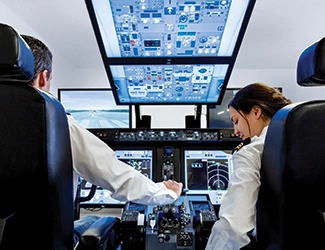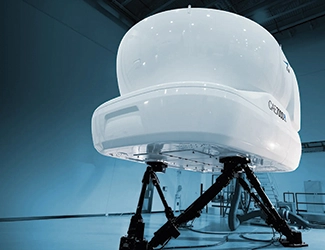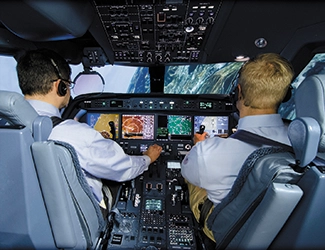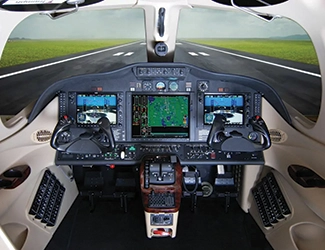Flight training
Seasonal slowdowns and training opportunities.
By Shannon Forrest
ATP/CFII. Challenger 604, G-IV
Contributing Writer

The year’s end and the beginning of the new year tend to be slow for most corporate flight departments. Aside from the occasional CEO or board member who wants to jet off to a tropical destination between the holidays, the weeks between mid-December and the end of January typically see reduced operations compared to the rest of the year.
Some departments take advantage of this slow season to perform heavy maintenance checks or upgrades on their aircraft. Another effective strategy is to use this time to send pilots for training.
Initial aircraft qualification events (and new type ratings, if applicable) have the most significant impact on the operational integrity of a flight department, as these curricula tend to be longer than requalification, periodic refreshers, or recurrent training.
The 2 most common scenarios that generate the need for initial courses are new-hires joining the department and pilots within the department transitioning to a different aircraft type within the same fleet.
Time spent in training is time away from the flight line, so training efficiency and timing are major considerations. If training can be conducted while an aircraft is out of service for scheduled maintenance, it can be beneficial to the bottom line.

Types of training
Training can be categorized into 3 types – need-to-have, nice-to-have, and enrichment. Need-to-have training is dictated by authority or regulation. Without it, a pilot cannot legally operate the aircraft.
The previously mentioned initial type rating is the most ubiquitous form of regulatory need-to-have training for professional pilots. According to US regulations, a type rating is required for the pilot-in-command (PIC) of heavy aircraft (those with a max takeoff weight [MTOW] of more than 12,500 lb) or turbojet-powered airplanes.
There’s some irony in the regulation itself, as seemingly more complex, round-gauge turboprops can escape the requirement, while lighter, simpler jets with advanced glass cockpits are subject to it. For example, the Mitsubishi MU-2B-60 has an MTOW of 11,575 lb – just under the type rating requirement.
In contrast, the Cessna Citation Mustang, which features an advanced Garmin G1000 avionics package and an MTOW of 8645 lb, requires a type rating. It’s fair to argue that the MU-2 is harder to fly than the Mustang – especially considering the writer’s bias from having 1000 hours as a single pilot in the MU-2 – but the rules are the rules.

In-aircraft vs sim training
While most type ratings are obtained through training in a motion-based simulator, they don’t have to be. Type rating requirements can be completed in the actual aircraft. There’s an ongoing debate among industry experts about the efficacy and safety of forgoing a simulator in favor of in-aircraft training.
However, the process is legal under certification requirements. Given the relatively low accident rate for professionally-flown turbine-powered aircraft, there is no demonstrable evidence that in-aircraft training makes a pilot less safe on the line.
The turbojet aircraft type rating most frequently obtained in the aircraft, rather than in a simulator, is for the Cessna Citation series. In this case, training providers typically send an instructor or examiner to a client’s location to conduct the training. Many of the recipients of this service are owner/operators. The 2 major benefits of this approach are convenience and privacy, especially if the client is highly recognizable or private.
Sim-based training providers
When it comes to simulator-based training, 2 industry giants dominate the market – FlightSafety International (FSI) and Canadian Aviation Electronics (CAE). Interestingly, both companies trace their origins back to the post-WWII 1950s.

CAE was founded by former Royal Canadian Air Force (RCAF) officer Ken Patrick, who aimed to “create something Canadian and take advantage of a war-trained team that was extremely innovative and very technology-intensive.”
The company began in a vacant hangar and focused initially on ground-based radar and communication systems. In 1952, CAE secured a contract from the RCAF to develop a flight simulator for the Avro Canada CF-100 Canuck.
Separately, FSI was incorporated by Albert Lee Ueltschi in 1951, with operations based initially at the Marine Air Terminal at LGA (La Guardia, New York NY). By 1953, Ueltschi, who was employed as a pilot by Pan American Airways, had purchased 4 rudimentary Link devices for pilot training. In 1962, FSI launched its first true type-specific simulator, featuring analog computers and hydraulic motion.
Both CAE and FSI saw explosive growth in the 1970s. CAE attributes its success to the economic conditions of the time, particularly the energy crisis, which made jet fuel prohibitively expensive. Simulators were cheaper to operate than aircraft for training purposes.
FSI’s success is also tied to its emphasis on safety. The 1970s were marred by a series of fatal aircraft accidents, which led to a belief that better-trained pilots could produce safer outcomes. Corporate pilots deserved access to the best advanced training available.
The use of simulators allows for a deeper understanding of how aircraft systems operate during failure scenarios, and enables pilots to practice maneuvers that would be too hazardous to perform in the air. Best of all, there’s the “reset button,” meaning that, if a maneuver doesn’t go as planned, it can be repeated until successful. This encapsulates the true definition of learning – a change in behavior resulting from experience. It’s better to gain that experience in a simulator than in the air.

SIMCOM uses a more realistic scenario that induces impairment in a
slower fashion.
Certified training providers
Both CAE and FSI are certified by regulatory authorities to deliver Level D initial and recurrent type-specific simulator training worldwide. They offer state-of-the-art technology, beautiful facilities, accommodating staff, world-class instructors, and even free coffee.
Unless dealing with a unique aircraft type or exclusive proprietary factory-authorized training, both providers deliver high-quality training for specific aircraft. For example, a Gulfstream type rating at CAE looks the same on paper as one at FSI.
Both companies offer user-friendly websites with easy access to training dates and locations. However, line pilots at midsize or large flight departments are unlikely to need this information themselves, as this responsibility typically falls to the chief pilot, training chairman, or department head.
Flight departments often have longstanding relationships with specific training vendors, which can be influenced by convenience (eg, a training facility location near the home base airport eliminates the need for airline tickets, rental cars, and hotel stays), perception (some departments may prefer one provider over the other based on brand loyalty or tradition), or cost considerations (especially during challenging economic times, when price sensitivity becomes more prominent).

Nice-to-have and enrichment training
Unlike the need-to-have courses, which are strictly regulated, nice-to-have and enrichment courses often diverge for proprietary reasons. Nice-to-have courses can be defined as those that are not required for legal operation but could improve safety or operational efficiency.
Many of these courses are offered in person or via online/electronic learning. For instance, CAE offers online courses in controller–pilot data link communications (CPDLC) operations, reduced vertical separation minima (RVSM), performance-based navigation, low-visibility operations, cosmic radiation, contaminated runways, thunderstorm avoidance, and international operations.
FSI offers similar courses, such as those on weather radar, traffic collision avoidance system (TCAS), terrain avoidance and warning system (TAWS), and controlled flight into terrain (CFIT). Although none of these courses is necessary to fly an aircraft, they can enhance safety or operational efficiency – for example, understanding radar intricacies combined with thunderstorm avoidance strategies.
FSI also offers a unique training format called LiveLearning, which is an instructor-led online course. Unlike traditional electronic learning courses, the instructor can adjust the direction and dynamics of the class in real time based on class engagement. This creates a more dynamic learning environment, as participants with different aviation backgrounds contribute to discussions, enhancing the overall experience.
Focused on the individual
Enrichment courses are designed to benefit the individual pilot and teach skills that can be applied to operations. One common course with widespread applications is crew resource management (CRM). Both CAE and FSI offer initial and recurrent CRM courses, with FSI also providing CRM in the LiveLearning format.
One notable enrichment course is offered by SIMCOM Aviation Training – the slow-onset hypoxia course. High-profile accidents over the past decade have highlighted the dangers of undetected hypoxia, with the most recent Boeing 737 inflight door detachment incident bringing the topic back into focus. While the door detachment is an extreme case, most hypoxia incidents are insidious and difficult to detect.
SIMCOM’s DeSat training program, delivered in partnership with the Southern AeroMedical Institute (SAMI), uses a Zodiac Aerospace mask system to simulate slow-onset hypoxia while flying a Garmin G1000-equipped aircraft. The session is recorded for later playback, allowing pilots to identify signs of impairment that might otherwise go unnoticed.
Blood oxygen saturation and pulse rates are monitored by medical professionals, with each session tailored to the individual pilot.
Hypoxia remains a leading cause of loss of control in-flight (LOC-I) accidents, underscoring the importance of this type of training.
Upset prevention and recovery training
An upset prevention and recovery course is designed to help pilots recover from an undesired aircraft state. Both CAE and FSI use simulators to teach recoveries from upsets, with technology that can predict whether an aircraft would exceed structural limitations during recovery. Prior to this, there was no way of knowing how much structural damage might have occurred during a real-world upset scenario.
However, a simulator-based course is not the only option. SIMCOM offers an upset recovery program in collaboration with Patty Wagstaff Aviation. This 2-day course culminates in training in an Extra EA 300/L aerobatic aircraft, where pilots gain real-time experience in returning an aircraft to controlled flight.
Pilots tend to have 2 attitudes toward training – they either love it or hate it. Regardless, it remains an essential part of professional aviation training, and, as with any training, you get out of it what you put in.
 Shannon Forrest is a current line pilot, CRM facilitator, and aviation safety consultant. He has more than 15,000 hrs TT and holds a degree in behavioral psychology.
Shannon Forrest is a current line pilot, CRM facilitator, and aviation safety consultant. He has more than 15,000 hrs TT and holds a degree in behavioral psychology.